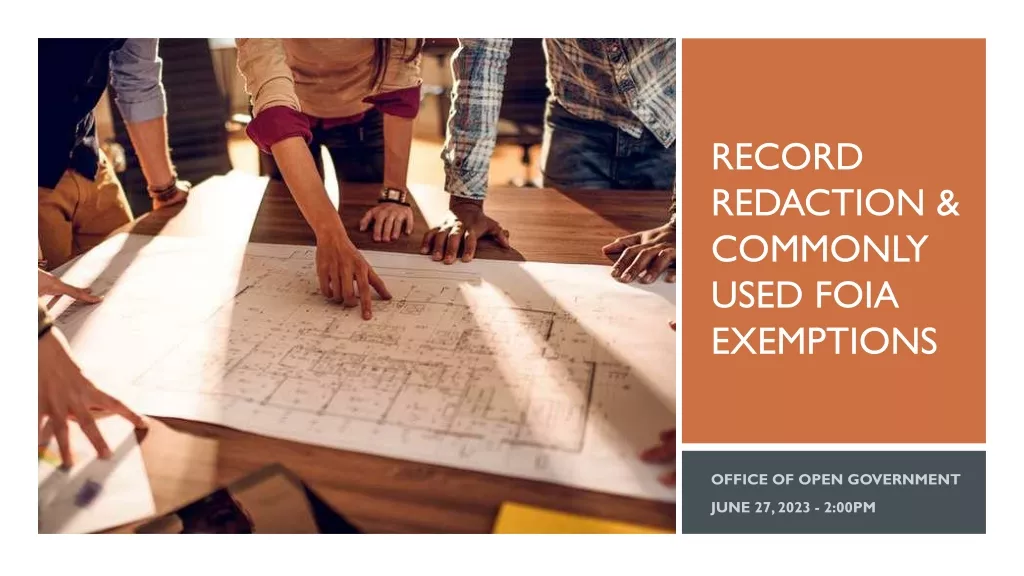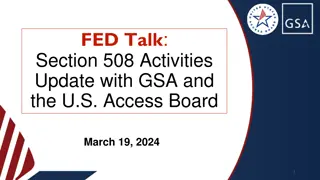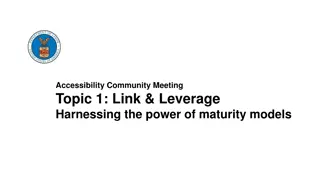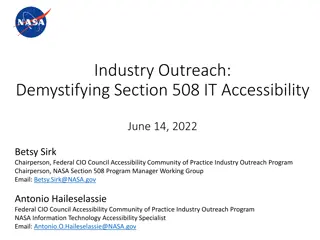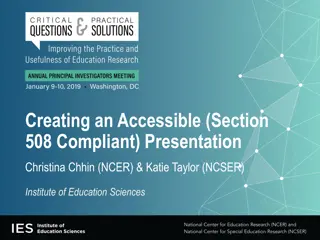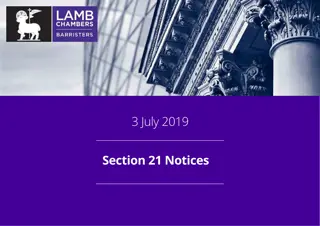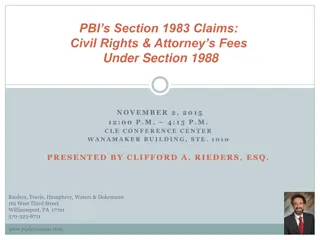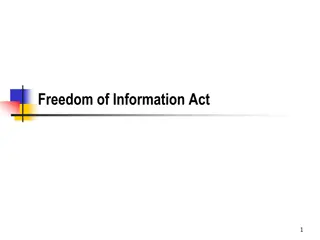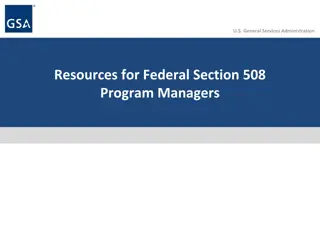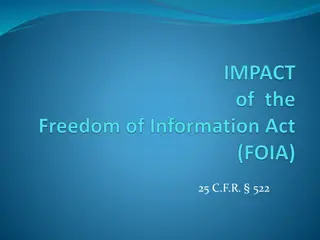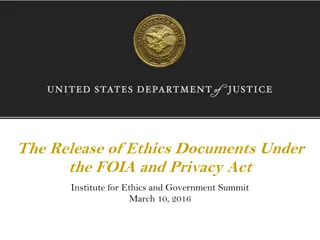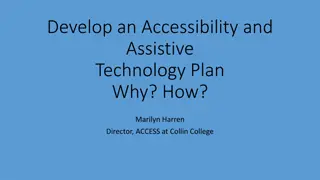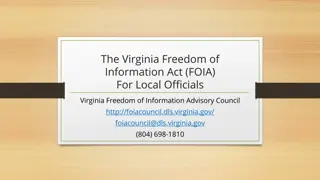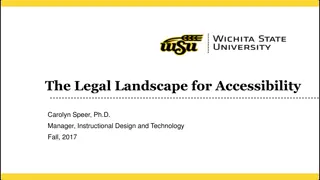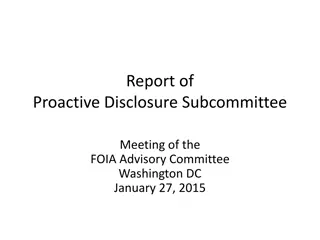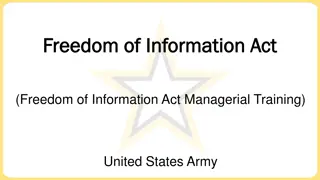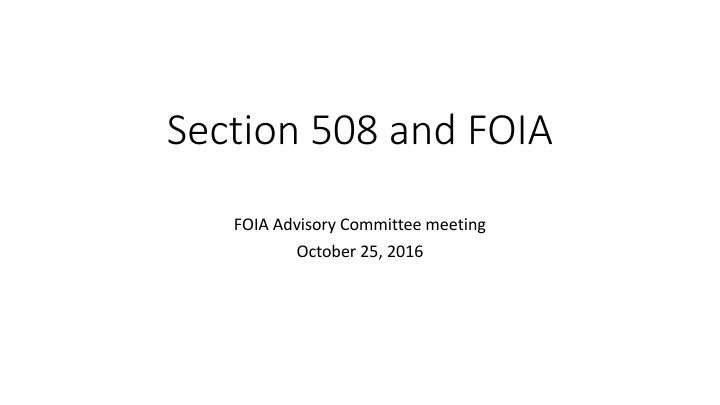
Federal Accessibility Initiatives and Organizational Structure Overview
Learn about Section 508 of the Rehabilitation Act Amendments, Federal agency accessibility requirements, technical assistance webinars, and the Chief Information Officers Council's mission to improve federal IT practices. Explore the organizational structure of the Federal CIOC's Accessibility Community of Practice, fostering collaboration among federal agencies, disability advocates, industry, and academia stakeholders.
Download Presentation

Please find below an Image/Link to download the presentation.
The content on the website is provided AS IS for your information and personal use only. It may not be sold, licensed, or shared on other websites without obtaining consent from the author. If you encounter any issues during the download, it is possible that the publisher has removed the file from their server.
You are allowed to download the files provided on this website for personal or commercial use, subject to the condition that they are used lawfully. All files are the property of their respective owners.
The content on the website is provided AS IS for your information and personal use only. It may not be sold, licensed, or shared on other websites without obtaining consent from the author.
E N D
Presentation Transcript
Section 508 and FOIA FOIA Advisory Committee meeting October 25, 2016
Presenters David Capozzi, Executive Director, U.S. Access Board Timothy Creagan, Senior Accessibility Specialist, U.S. Access Board Helen Chamberlain, Sec508 Training & Outreach Program Director, Office of Governmentwide Policy, General Services Administration
Section 508 of the Rehabilitation Act Amendments When Federal agencies develop, procure, maintain, or use electronic and information technology, they must ensure that it is accessible to Federal employees and individuals with disabilities who are members of the public seeking information or services from a Federal agency unless an undue burden would be imposed on the agency Access Board sets standards; incorporated in the Federal Acquisition Regulations Access Board and the General Services Administration provide technical assistance
Technical Assistance Bi-monthly webinar series on Section 508 issues (2013 present) https://www.access-board.gov/training/webinars
Chief Information Officers Council (CIOC) Principal interagency forum on federal agency practices for IT management Mission is to improve practices related to the design, acquisition, development, modernization, use, sharing, and performance of federal government information resources https://cio.gov
Organizational Structure of the Federal CIOC Accessibility Community Federal CIO Council of Practice Accessibility Community of Practice Vendor /Acquisition Outreach Subcommittee Education Subcommittee Best Practices Subcommittee Document Accessibility Community of Practice Web Content Community of Practice Section 508 Testing Community of Practice 6
CIOC Accessibility Community of Practice The U.S. Access Board, the Department of Justice, and the General Services Administration, and federal agencies working together What do they do? Provide a forum for federal agencies, disability advocacy groups, industry, and academia stakeholders to support the federal government s implementation of accessible information technology Discuss cross-agency issues regarding Section 508 implementation Provide resources such as training curricula, tools and guidance to assist agencies with Section 508 implementation Encourage agencies to share successful practices and information with each other Engage disability advocacy groups, industry, and academia to tap into new sources of information and innovation for accessible technology Increase awareness of the Section 508 law, and regulations https://cio.gov/about/groups/accessibility-cop/ 7
Are documents covered by current 508? Electronic documents meet the 508 definition for EIT 1194.4 Electronic and Information Technology (E&IT) Includes information technology and any equipment or interconnected system or subsystem of equipment, that is used in the creation, conversion, or duplication of data or information. [Examples omitted] From Section508.gov Frequently Asked Questions: Question C.7.i: Must Portable Document Format (PDF) files that are displayed on a Federal website meet the Access Board s standards? Answer: Yes So what standards to use?
Guidance for Documents Section508.gov Look at Best Practices CIO Council Accessible Electronic Document Community of Practice Basic Authoring and Testing Guide - MS Word 2013 Basic Testing Guide for PDF Excel and other file formats under development Create Accessible Electronic Documents A compilation of federal guidance, checklists, and testing information for creating and maintaining accessible documents in various popular electronic formats, including Word, PDF, Excel, and PowerPoint. Sources for these resources are identified by abbreviations for federal components. Other valuable guidance from non-federal sources, including industry and academia, can be found from internet search using relevant keywords such as "accessible document". http://www.section508.gov/content/build/create-accessible-documents
SECTION 508 BASIC AUTHORING AND TESTING GUIDE MS WORD 2013 MS WORD 2013 This document covers MS Word 2013 (.docx) formats in 5 categories: Document Formatting Text Formatting Object Formatting Color Formatting Miscellaneous
USE STYLES TO CREATE HEADINGS Headings are used to break-up content and make finding information easier. AT cannot infer meaning from just formatting (such as bold or underlined text). Styles create a structure that AT can quickly access. Author Accessibly Go to Home>Styles and use styles when creating Headings in your document
To use Styles, you can either: 1) Click on the style you want and then type your heading, OR 2) Type your heading and then click on the style you want to use If you have different heading levels (such as Major, Section, Subheading, etc.) that look different, you must use a different Style for each type of heading. You can modify Styles so that you can create the look and feel you want in your document. Table 1: Example of Heading Levels for each Heading Type Heading Type Visual Characteristics Heading Level Major Heading 16 pt. font, no indent, bold Heading Level 1 Section Heading 12 pt. font, indent, bold Heading Level 2 Subheading 12 pt. font, indent, italicized Heading Level 3
Use Styles to Create Headings Check Your Work To check your work, you: 1) Open the Navigation Pane (Ctrl + F); make sure it s on the icon to browse headings 2) Check that all of your headings appear in the navigation pane and match the visual outline of your document
DUPLICATE VITAL INFORMATION IN HEADERS, FOOTERS AND WATERMARKS Screen readers do not automatically read information in headers/footers and watermarks. Therefore, vital information (such as Respond by X Date, CONFIDENTIAL, or Do Not Distribute) must also be duplicated at or near the start of the main content area. Author Accessibly: Duplicate vital information in the Header/Footer or Watermark at or near the start of the related information (such as the beginning of your document or the start of a section).
Check Your Work To check your work, you: 1) Look for vital information in headers, footers and watermarks. 2) Go to the start or near the start of the related information and ensure you have duplicated vital information (such as Respond by X Date, CONFIDENTIAL, or Do Not Distribute).
Section 508 Basic Testing Guide Section 508 Basic Testing Guide PDF (Portable Document Format) PDF (Portable Document Format) - - DRAFT DRAFT This document is divided into the following 6 categories: Preconditions Document Properties Structure Tags Objects Color Miscellaneous
Tagged PDF To check for Section 508 accessibility, the document must be a Tagged PDF Inspect The PDF: 1) Open Document Properties (File > Properties > Description) 2) If you find Tagged PDF: No, return the document to the author with reference to the AEDCOP Section 508 Basic Authoring Guides
Tags Screen readers rely on tags to interpret the document structure (headings, paragraphs, lists, images, data tables, forms, and other objects. All meaningful text and objects must correspond to a tag and the order of tags must follow the visual/logical order. Inspect The PDF: 1) Open the Tags pane (View > Show/Hide > Navigation Panes > Tags). 2) Press Ctrl and left click on the plus symbol to expand all tags. 3) Select a tag to highlight the corresponding content on the page. If you do not see the light blue highlighting, then turn on Highlight Content (Tags Pane > Options > Highlight Content). 4) Press Ctrl + A to select all tags. 5) Check that all meaningful text and objects are highlighted. 6) Use the up and down arrow keys to move through the tags. 7) Check that the tags follow the visual/logical order on the page
Tags Example of tags that follow the visual/logical order
OGP Office of Information, Integrity, & Access Helping Federal leaders tackle their ICT and policy challenges Section 508 ( Section 508 ( 508) was enacted to eliminate barriers in information technology, to make available new opportunities for people with disabil 508) was enacted to eliminate barriers in information technology, to make available new opportunities for people with disabiliti ities, and to encourage development of technologies that will help achieve these goals. The GSA/OGP Section 508 Program provides technical assistance to Federal agencies and the US Postal Service by developing, d The GSA/OGP Section 508 Program provides technical assistance to Federal agencies and the US Postal Service by developing, depl compliance and conformance with compliance and conformance with 508. es, and to encourage development of technologies that will help achieve these goals. eploying, and managing policies, guidance, tools, websites, training and resources to help improve oying, and managing policies, guidance, tools, websites, training and resources to help improve 508. Our Goals: Our Goals: Buy Accessible Buy Accessible Build Accessible Build Accessible All Federal ICT are accessible All Federal ICT are accessible Be Accessible Be Accessible A consistent yet flexible approach to A consistent yet flexible approach to 508 Program operations grounded in best practices, exists across the operations grounded in best practices, exists across the federal government federal government 508 Program Striving for all Federal solicitations to comply with Striving for all Federal solicitations to comply with 508 requirements in advance of award. requirements in advance of award. 508 What We Do: What We Do: Provide Procurement Guidance & the BuyAccessible Tools : Provide Procurement Guidance & the BuyAccessible Tools : Procurement requirements 508 review assistance BuyAccessible Quick Links Provide Website Assessment Guidance & Tools (508 Conformance:) Provide Website Assessment Guidance & Tools (508 Conformance:) Promote the DHS Trusted Tester Program (for IT Developers) Provide tools and assistance for assessing 508 conformance of websites (via Pulse.cio.gov) Host Section508.gov as the primary portal for the Accessibility Community Host Section508.gov as the primary portal for the Accessibility Community Provide information and a one-stop venue for tools, guidance and resources on 508 laws, standards, & acquisition regulations Promote & Lead Agency Section 508 Program Maturity Promote & Lead Agency Section 508 Program Maturity Share Government-wide Best Practices Lead and Coordinate Training & Professional Development Lead and Coordinate Training & Professional Development Section508 Universe Training at section508.gov Micro Purchase Training at www.fai.gov (FAC 047) Trusted Tester Training and Certification at www.FAI,gov Host meetings and informational seminars that bring industry and government together to network, explore new technology, and best practices For more information contact: Helen Chamberlain at For more information contact: Helen Chamberlain at helen.chamberlain@gsa.gov helen.chamberlain@gsa.gov

